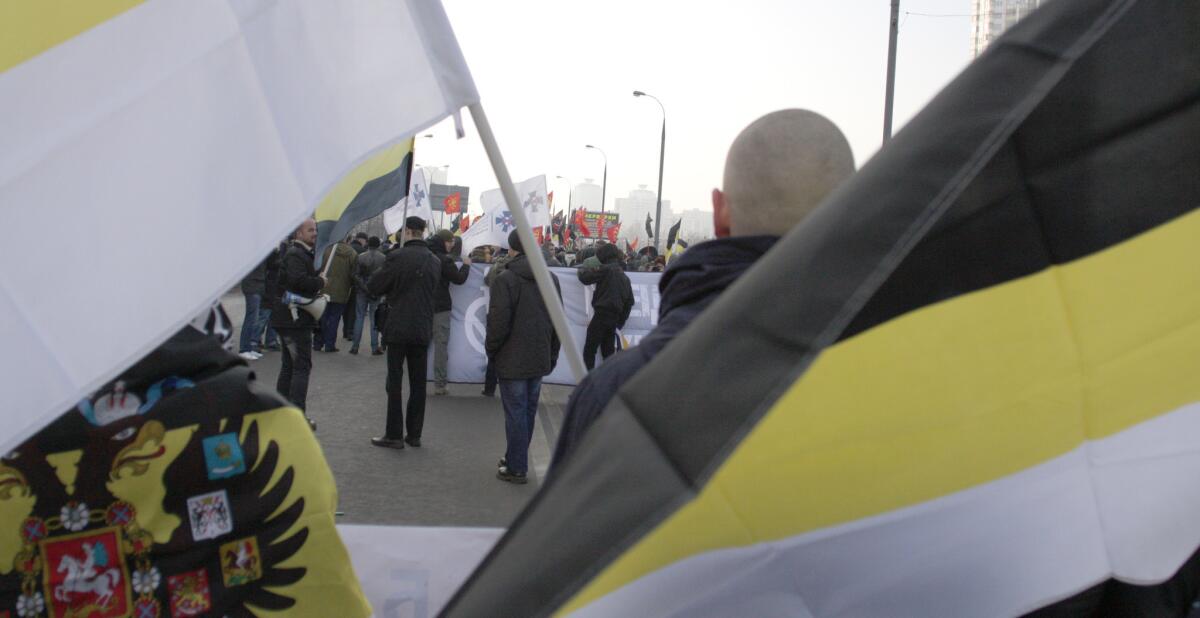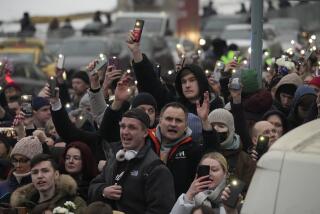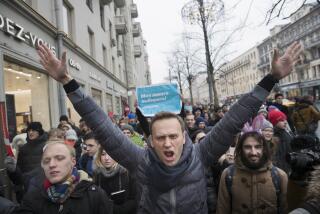White supremacist gathering underscores Russia’s nationalist trend

A young Russian skinhead stands behind an imperial Russian flag during the Russian March, an ultranationalist rally.
The protesters, several thousand strong and surrounded by hundreds of armed police, chanted nationalist slogans and racial slurs, occasionally raising their right hands in a Nazi salute.
It was the 10th annual gathering of white supremacists, neo-Nazis and far-right nationalists, held in Moscow in November.
“Nationalism has a bright future in Russia,” said co-organizer Dmitri Demushkin, 36, a former skinhead and ex-leader of the Slavic Union, a banned group whose Russian initials, SS, intentionally mimic those of the Nazi paramilitaries. “We will either win or the Russian people will die.”
The very existence of homebred neo-Nazis and racists, made graphically clear each year in what is known as the Russian March, is still shocking to many in Russia, a multiethnic country that once professed to be building an internationalist, communist utopia and still prides itself on the victory over Nazi Germany in World War II.
Yet Russia’s far right isn’t limited to a few marginal figures. It is a vortex of militant gangs, movements and political parties that enlist tens of thousands of members who are also among those most loudly applauding President Vladimir Putin and his strong-arm policies against Ukraine and other former Soviet republics.
The Kremlin cracked down on right-wing radicals who emerged after the 1991 Soviet collapse and mushroomed in the 2000s in response to Islamist terrorism attacks and the influx of millions of migrants from Central Asia and Russia’s mostly Muslim Caucasus region, where two wars in Chechnya fueled racism and unrest.
In 2006, a neo-Nazi group organized seven bombings across Moscow, one of which killed 14 people at an outdoor market, including two children. Most of the victims were foreign labor migrants.
At the peak of racially motivated violence in 2008, at least 110 people were killed and 487 wounded, according to Sova, a Moscow-based hate crimes watchdog organization.
Such crimes have declined sharply since a crackdown on ultranationalists began about five years ago. In the first half of this year, four people died and 37 were wounded in racial violence, Sova reports.
But even as the Kremlin sought to rein in the violent right, it also incorporated elements of the nationalist agenda as part of its anti-Western and isolationist ideology that praises the “unique Russian civilization” devoid of “decadent” liberalism.
Officially tolerated expressions of racism such as the Russian March have nurtured the growing xenophobia and intolerance gripping Russia today. Some 54% of Russians support the idea of “Russia for ethnic Russians,” and more than a third would welcome the expulsion of Caucasus and Central Asian Muslims, according to the latest poll on the matter, a July 2014 survey by the independent Levada Center.
“The current government partially declares the imperial slogans we declared almost 25 years ago,” said Eduard Limonov, a novelist and leader of the now-banned National Bolshevik party.
In the 1990s, the National Bolsheviks — whose red flag is modeled on a Nazi banner with a hammer and a sickle replacing the swastika — advocated armed revolts to carve out regions of Ukraine, Latvia and Kazakhstan that are largely populated by ethnic Russians.
That scenario has played out in eastern Ukraine for the last 14 months, with Moscow-backed separatists occupying the predominantly Russian-speaking regions of Donetsk and Luhansk.
Far-right nationalists have been polarized in the Ukraine conflict, with some fighting on each side, Sova reports.
“They all are doing military training, all of them. It has become very trendy,” Sova director Alexander Vekhovsky said. “All the time, trainings, musters, camps. And this is very concerning, because it’s not going to end well.”
The conservative and immensely powerful Russian Orthodox Church, resurgent czarist-era paramilitary Cossacks, and right-wing parties represent the largest players in the field of official, Kremlin-sanctioned nationalism.
Its superstar is Vladimir Zhirinovsky, a veteran politician who served as a deputy speaker of the State Duma, Russia’s lower house of parliament, and heads the LDPR party that holds 56 of the 450 Duma seats.
The flamboyant 69-year-old ran for president five times, campaigning on promises to expel non-Russians, install barbed wire around Chechnya and Dagestan, Russia’s violence-plagued Muslim provinces, and “return” Ukraine, Belarus and the Baltic states to the Russian empire.
But his pledges and party are widely seen as pseudo-opposition, a Kremlin tool to “sterilize nationalist voices,” says Andrey Kolesnikov, a political analyst with the Moscow Carnegie Center think tank.
“Just because the state wants to preserve its monopoly on nationalism — and this is one of the most important political aims because such ideology is popular and it, among other [factors], keeps Putin’s ratings high — it responds very harshly to any manifestations of nationalist extremism,” Kolesnikov said.
The two sides of Russian nationalism — banned and co-opted — often converge.
Half a dozen pro-Kremlin youth movements emerged after the 2005 pro-West “Orange Revolution” in Ukraine. Created to counter opposition street rallies in Russia, they recruited racist soccer fans and ultranationalists and used their slogans, according to rights groups, anti-Nazi bloggers and Russian media.
The founder of a brutal neo-Nazi gang recently claimed to have “cooperated” with two such groups.
Ilya Goryachev was sentenced to life to prison in Russia in late July after a jury found him guilty of establishing BORN, or the Military Organization of Russian Nationalists.
Unlike other neo-Nazi gangs that preyed on dark-skinned non-Russians, the group mostly targeted “traitors of race,” or ethnic Russians who stood up to the far-right ideology, and planned to seize power to turn Russia into a neo-Nazi “Fourth Reich.”
From 2008 to 2010, BORN militants killed 10 people, including a federal judge who had sentenced several ultranationalists to jail, a human rights lawyer, a journalist and three anti-Nazi activists. Its militants also killed a Muay Thai world champion and a Tajik man whose severed head was planted in a government office with a note promising more killings.
Several BORN activists have already been sentenced to lengthy jail terms or life. Goryachev testified against them, pleading not guilty at his own trial and claiming he was merely a publicist.
He told the court last month, “I was talking about the things that are now broadcast on the Russia television channel,” a state-run national network.
Mirovalev is a special correspondent.
More to Read
Start your day right
Sign up for Essential California for news, features and recommendations from the L.A. Times and beyond in your inbox six days a week.
You may occasionally receive promotional content from the Los Angeles Times.






